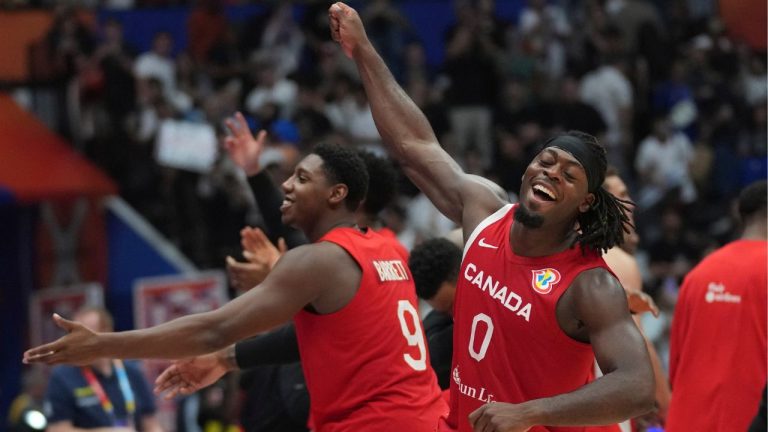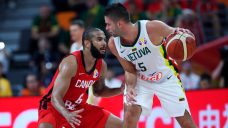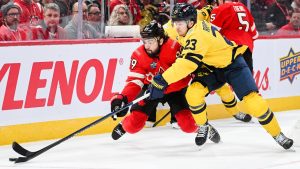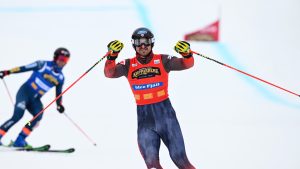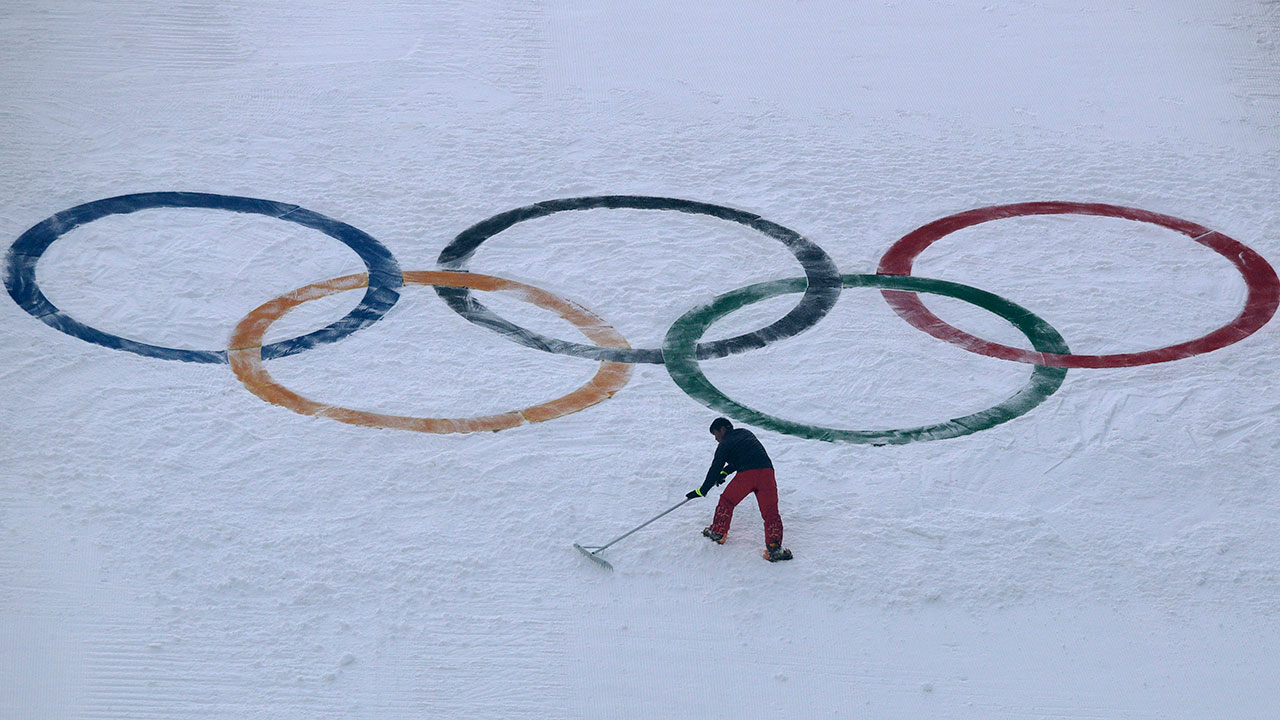On a day that has been — almost literally — at least a decade in the making, it was still hard not to focus on who wasn’t going to be in training camp with the Canadian men’s basketball team, rather than who will.
It’s an ancient tradition, an old habit, born of the days when Canadian basketball fans would hope and wish certain players would commit some of their off-season to representing Canada internationally, and only be more disappointed about the ones who didn’t rather than celebrate those that did.
But here’s the twist, evidence of how things have changed: a very powerful way to appreciate how impressive the group that men’s team general manager Rowan Barrett has assembled in advance of the 2024 Olympics in France later this summer is to reflect on those who aren’t even competing for a spot on a team that — on paper — is a very real threat to take home any colour of medal.
Taken as a whole, it’s a group that most countries outside of the USA and perhaps France, would be eager to work with.
These are some of the players carrying Canadian passports who for various reasons won’t even be in camp or under consideration for a position on the team when the balls get rolled out under the watchful eye of newly-appointed Brooklyn Nets head coach Jordi Fernandez next Friday: NBA veterans Tristan Thompson, Cory Joseph, Brandon Clarke and Chris Boucher, for starters. Each of them has a championship ring or significant playoff experience. Then you have Bennedict Mathurin and Shaedon Sharpe, a pair of recent lottery picks oozing star potential who will be in camp but won’t be competing for a spot because they haven’t been cleared after season-ending injuries.
Then there are the guys who were projected to do great things and should be at or near their prime, but never quite panned out, such as former first-overall pick Anthony Bennett and Nik Stauskas, who was taken eighth-overall in 2014, and Tyler Ennis, who was taken 18th that year, but could never shake the injury bug.
And then there’s the group who are still developing in their careers and have shown flashes of promise at the NBA level, such as Dalano Banton, Olivier-Maxence Prosper, Leonard Miller, Joshua Primo and Eugene Omoruyi.
And beyond all of them are a small platoon of elite European professionals who have shown to be useful contributors at the FIBA level in the past.
It’s an embarrassment of riches that Canada doesn’t even need to dip into.
This time when laying out who’s not under consideration for a spot on the Olympic team, it only serves to prove how impressive the 20 names that will be competing when training camp opens are, starting a month-long build-up to the beginning of the Olympics on July 27.
It starts with the seven returning NBA players that helped Canada win bronze at the FIBA Basketball World Cup last summer, led by two-time, first-team all-NBA selection Shai Gilgeous-Alexander and supported by Dillon Brooks, RJ Barrett, Kelly Olynyk, Lu Dort, Nickeil Alexander-Walker and Dwight Powell.
New to the team will likely be Denver Nuggets star Jamal Murray, emerging Indiana Pacers guard Andrew Nembhard and Golden State Warriors wing Andrew Wiggins.
Those 10, if healthy, seem like a safe bet to be on the plane for Europe after Canada’s exhibition game against Team USA in Las Vegas on July 10.
After that? For the remaining two spots on the 12-man roster, Barrett and Fernandez will have to choose from the likes of Sacramento Kings big man Trey Lyles, former Raptors big man Khem Birch — back to full health after a pair of injury-marred seasons — and then determine the availability of two-time NCAA player-of-the-year Zach Edey, whose fate may be determined by which team he gets drafted by on June 26. As well, there is European-based big Mfiondu Kabengele, a former first-round pick, Kyle Alexander, who was on the World Cup team from last summer along with Philip Scrubb, and Thomas Scrubb who has played in more World Cup qualifying games than any Canadian ever.
It's kind of mind-boggling when you lay it out that way and goes a long way to erasing the disappointments that have come from making just one Olympic appearance — a seventh-place finish in Sydney in 2000 — since 1988.
It’s hard not to be optimistic; excited even.
“I believe that our program is in a strong place, and we're growing. And I believe that this is the beginning,” said Barrett while announcing the training camp roster on Wednesday afternoon. “Why do I say the beginning? Well, the work that we've been doing over the past decade to build our system, to build our athletes, to build our programs, driving things with the coaching and our organization's growth over that time has put us in a position now that I believe firmly that we have a player pool in the pipeline that stocks us out to the 2032 Olympics and beyond. This is the beginning for us, we believe. We are ready and we will be taking on all comers.
"But in the end, I think our goals need to be very clear. For this summer, we are working towards climbing up to the top of that podium. We are going to this competition in Paris to win. That's our plan. That's what we're stocked to do. And as a result of that, we have to create the strongest possible roster that we could to get that job done.”
Canada is on a mission, which leaves little room for sentiment. Two years ago Canada introduced the concept of the ‘summer core’ — 14 players who committed to be available in the qualifying process for the World Cup, at the World Cup itself and then at the Olympics this summer. By definition, not all of the 14 could be guaranteed a spot on the Olympic roster, given there are only 12 available, but it was notable that two of the 14 didn’t even get an invitation to training camp, with Kevin Pangos and Joseph left off the list. Pangos is coming off an injury-marred year in Europe, but Joseph was planning on being in camp until he was told otherwise on Friday.
“I think all of our athletes that signed up this [Olympic quadrennial] understood that 'I don't have a guarantee in the end to be on the team.' Right? And so that conversation is always going to be difficult,” said Barrett. “[But] as a player you want to play. You believe in yourself. You believe in what you can do, and you want an opportunity but there's only 12 players in the team.”
The standard is high, and even coming off a bronze medal, Canada has holes to fill. At the World Cup Canada was No.1 in the tournament on offence but 13th in the 32-team field in points allowed. Canada is well stocked with perimeter defenders in the form of Brooks, Dort and Alexander-Walker, but could use some additional size when matching up against the likes of France, the USA and Serbia, as examples.
“Evaluating ourselves coming out of the World Cup last year, we could see that there are still some areas that we need to grow,” said Barrett. “We're trying to get up to the top of the podium. It looks like two small steps. It is not. They are two large steps that you have to jump up. And with these teams reloading all around the world and looking at some specific areas that we felt we needed to bolster and strengthen, we could not simply look within our core of athletes. We have to look within our whole entire player pool to give us what we believe we might need.
“These teams are gonna reload. They're gonna have their very, very best there, and when you get into the deep, deep areas of these competitions and the guts of these games, you know, they have some challenges,” said Barrett. “They have some questions that you need to answer on the court. So we're trying to build something that can give us the opportunity to answer all questions when we get into these games.”
As well as Canada performed last summer, adding additional shot creation and shooting was vital, which is why Murray — who last dressed for the national team in 2015 — and Wiggins, who declined to make himself available as a member of the ‘summer core’ in the previous two years, are so crucial.
“Pardon the expression, but if you’re going to go into a war, then sometimes you might need a nuclear option and [Murray] is the type of guy that in the fourth quarter, will detonate a game,” said Barrett.
And as for Wiggins, who played for Canada in Olympic qualifying in 2015 and 2021, Barrett said: “Andrew Wiggins is a pro. Every time he’s been within our walls he’s played extremely good basketball … a healthy, strong Andrew Wiggins is a very, very, good player.”
It’s a category — very, very good basketball players — that Canada has slowly and progressively become remarkably flush with options. It should make for a competitive training camp and a team that can challenge the best in the world.
It’s been a long time coming.
